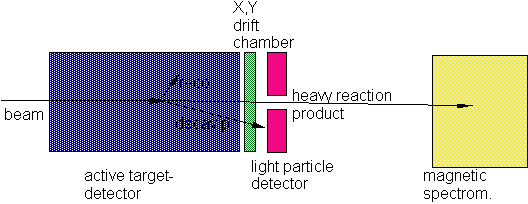
| Nuclear Physics Group |
Physics Department
Conferences
Seminars
Useful Links
IT Resources
Feedback:
support@ns.ph.liv.ac.uk
|
ACTAR - Detector Concept
The active target detector is a very novel gas detector concept where the gas constitutes both the target and the detection medium. Generally, highly inverse reactions will be used where the target gas is p, d, 3He or 4He, either pure or mixed with standard detection gases such as isobutane C4H10. The working principle of the detector is based on the Time Projection Chamber (TPC). Ionisation electrons produced by charged particles passing through the active target gas drift under the influence of an electric field to the readout plane where they produce avalanches on anode wires. The image charge from the avalanches is detected on a cathode plane that has been divided into pads. Typically the image charge from one avalanche will spread over several pads and the resultant distributions can be used to obtain the localisation of the hit in two dimensions. The signal on each of the pads in the active target is also sampled in time and from these samples the arrival time of the pulse can be determined, providing a measurement of the height of the track above the given pad. In this way three dimensional track reconstruction can be achieved. Many TPC detectors also use magnetic fields, either solenoid or dipole, and one of the aims of the project will be to apply this to the active target concept. The resultant curvature of the trajectory can be used to determine the momentum of the particle. The magnetic field also reduces the spreading of the charge cloud resulting in better spatial resolutions. Typically the active target will be used with ancillary detectors so that all reaction products can be fully identified and characterised. A possible scheme is shown below.
In the figure, the incident particles from the secondary beam enter the active target. If a nuclear interaction takes place, the particle of the detector gas will recoil and will be detected in the active target via the ionisation of the gas medium. Light particles emitted by the excited heavy reaction product may not be stopped in the active target (though their angle will be determined) but can be detected by the forward angle light particle detectors. The heavy reaction product, only slightly deflected from the incoming direction, may also not be stopped in the active target but can be detected in a forward angle spectrometer that will provide mass and Z identification of the final product. The centre-of-mass energy resolution will be determined mainly by the geometrical resolution of the active target detector. With a position resolution of 0.5 mm, we expect an angular resolution of the order of 6 mrad for recoil ranges of the order of 10 cm. The range will be determined with a precision of 0.5mm, of the order of 1%, which corresponds to an energy resolution of 0.5%. Thus, for 10 MeV this equals 50 keV, a value comparable to the best results obtainable with solid-state detector systems. The influence of energy loss in the target on the final energy resolution will be eliminated, because the location of the reaction is measured event-by-event. The active target should be able to work with beam intensities of up to 105/s. Typical cross sections for the reactions considered are 1-10 mb. With 104/s incident particles, a detector gas pressure of 1 atm, and 100% efficiency, one can expect 20-200 counts/hour. Therefore, within a few days sufficient statistics should be obtained. The lower limit of 102/s should give access to a broad range of nuclei very far from stability. The aspects already discussed, such as extremely low energy threshold and the high efficiency, make such a device complementary to more classical detectors such as Si-devices. The research of optimised geometries with simulations of key reactions will be an essential contribution in the study of reactions with low intensity secondary beams. High quality ASIC electronics should provide a means to a new step forward in the practical realisation of such a device. Clearly in the above example the dynamic range of the active target is not sufficient to fully determine the reaction kinematics without ancillary detectors. One of the aims of the project is to study how this dynamic range can be optimised. This impacts on many areas of the design such as the detector geometry, whether to use a magnetic field or not, the detector gas and the readout chambers and electronics. |
| © University of Liverpool | Disclaimer. | |
